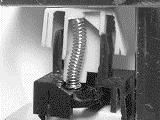Short answer:
Cherry mx linear Grey (still in production) at around 80g actuation and then there are two discontinued switches, the
cherry mx "space black" with 100-120g and the
cherry mx super black with 150g linear
Not that hard to find, but not guaranteed that all keys work evenly, as you buy second hand.
A little bit of background information goes a long way:
This is a Cherry MX Green switch Actuation Force:
80g
There are 3 types of keys:
- Linear. The keystroke is consistent and smooth.
- Tactile. A bump in the middle of travel, usually around the actuation point.
- Clicky. A bump in the middle of travel accompanied by a sharp “click” sound.
From this article 2013
The greens'
105 g bottom-out force, meanwhile, is far above that of other offerings, even the old IBM Model M.
For reference, the actuation graph in
IBM's buckling spring patent suggests the Model M requires around
70 g of force for actuation and 80 g to bottom out.
However, the Green is marketed as being a
80g,
see this list (with virtually all bigbrand keyboard switches, except Zelio which maxes out at 78g)
here are animated gifs of the innner workings
here is a graph with their travel vs resistance (in cN, centi Newton I presume)
other links:
reddit (list with actuation force)
Or better: find the right keys (type, for example, "Actuation Force:
90g" into google), then
do it yourself (very fun page about keyboard fanatics)
Anything above 100g actually shows Ergonometrics and medical problems. As is: Why do you want a keyboard that is so hard?
And experiment: buy pens with hard springs, replace them in your keyboard... test... (put a small wooden block and coins on top on the key until it clicks, weigh the contraption on a digital food scale... not precise, but cheap)
[doublepost=1505199497,1505198746][/doublepost]That reminds me: I need to repair my keyboard...




